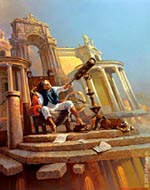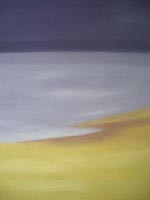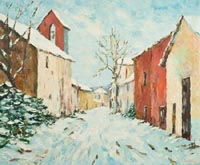 home
about
artists
exhibitions
press
contact
purchase
home
about
artists
exhibitions
press
contact
purchase |
|||||
|
The
Exhibition ‘Until The Morning Star’ |
|||||
|
Stanislav Plutenko:
The Moscow based artist
Stanislav Plutenko
was first introduced to the British with a one-man show at the Institute
of Contemporary Art in 1996. But it is in October 2002 that the Hay Hill
Gallery organised his second UK exhibition and has been representing his
new works to the British public ever since.
His own original
method of painting — the mixed technique with use of oil, tempera,
acrylic, watercolours, is skilfully supplemented by masterly application
of an "air brush" and the finest glazing by transparent paints.
The artist Stanislav
Plutenko plays on colour contrasts, his painting is very vigorous,
illustrative and imbued through by sarcasm on the reality. In spite of
the fact that the characters of his pictures are fattened and absolutely
earthly ones, they are always astir - running, fluttering and flying
somewhere. Having awkward bodies and unprepossessing faces they feel
themselves angels and we are sympathetic towards them with their
naiveté. With an identical acuteness he presents images of the people
and visual psychological surroundings. In each genre stage with elements
of grotesque style we can find the small history of life with symbolical
underlying theme. His pictures stimulate in the spectators the scale of
feelings, down to the protest, but not the indifference …
Stanislav Plutenko
was born in 1961 in Moscow. He drew and painted through his childhood,
but as his parents disapproved of his being a painter, he studied in the
turbine construction department of Moscow Machine Construction
Institute. Although it was after army service, where he was appointed
painter in the Officers Club and met many other painters that he became
a designer.
He studied at the
Academy of the National Economy named after M.Plekhanov and at the same
time took private art lessons from the art masters of different work
style. From 1981 he worked as a show-window dresser, continuing to study
painting in art studios. But it was from 1984 that he started showing
his work in exhibitions. In 1988 he worked with «Arbat 48», «Arbat 34»,
and «Mars» galleries. Since 1991 he has been a member of the
Professional Graphic-Artists’ Union. In 1997 he was rewarded with Grand
Prix of the «Golden Brush» exhibition. In 2007 Stanislav
Plutenko has received a rank of International Academy of Creative
Endeavors. In 2008 he was awarded with an Order of 'Peter The Great' for
"his deserts in the development of Russian Culture and Arts". In 2009 he
was awarded by a Gold Medal named after N.Sats "for the outstanding
creative achievements in the art development".
Plutenko's work has been shown many times over the last years, including
the exhibitions in Moscow (from 1988), Stockholm and Helsinki at
Interart 89 (1989), Chicago, USA (1990), Ulm, Germany (1991).
Bruce Clark was born in London in 1937. He studied
painting and sculpture at one of the most famous of English Art
Schools, the Bath Academy of Art at Corsham. He gained his initial
qualification there in 1960 working under artists who had gained or
were about to gain international reputations, including the young
Howard Hodgkin. He also holds a Diploma in Art Education and was
later awarded a Master of Arts degree by the University of Kent.
Having held several teaching and lecturing posts from 1960 onwards
he decided in 1996 to paint full-time. Throughout the past five
decades his work has been widely shown in the U.K., France and North
America. He has been included in publications such as 'Who's Who in
Art', the 'Dictionary of International Biography' and 'Artists in
Britain since 1945', and has written a number of research papers.
Throughout his long painting career Bruce Clark has
constantly experimented within a wide range of styles and
techniques, both abstract and figurative. A common thread in much of
the work has been a strong landscape element, the favoured locations
both real and imagined often being lonely, desolate and mysterious
places. Other themes have been inspired by literature, mythology,
genealogy, architecture and also the simple geometry to be found
within a wide variety of artefacts. Hard edge techniques have been
employed where appropriate alongside more painterly methods on other
occasions. There has been no single approach, no set formula, but
there has been a general move towards simplification and
clarification. Extensive travels have been influential, especially
in Scandinavia, U.S.A. and Japan. Bruce Clark has also had poetry
published in various magazines and anthologies and won an Itoen
award for a haiku in English. (Tokyo 1994 ).
GROUP EXHIBITIONS including
William
Foreman:
One of
the most well-known contemporary landscape painters, who has been
exhibiting regularly from 1961, Foreman was entirely self-taught.
He began painting, whilst stationed on Gibraltar in the RAF; he received
encouragement from the Scottish artist Ian McNab, who told him he had
potential. Foreman with the backing of his wife Lesley resigned from the
RAF and began to paint professionally, although he worked on a farm in
Cambridgeshire to pay the bills and joined the Cambridgeshire Drawing
Society. His initial works were watercolours, although Foreman was
using tubes of watercolour paint as you would oil. McNab suggested
his technique was more suited to oils and he has continued to work in
oils to this day.
It was
after a successful one man show in Ipswich, that Foreman and his family,
(with a son and two daughters by now), decided to become a full time
artist and they moved to Aberdeenshire, where they still live. It
was also at this time, that Foreman first started painting in France, at
the foot of the Pyrenees. He continues to return to France two or
three times a year to paint. It was while he was painting in a
field, that a Parisian dealer Monsieur Daninos with seven galleries,
stopped to see his work, and Foreman subsequently had exhibitions in
Paris for the next seven years. Foreman then introduced himself to
the Richmond Gallery on Cork Street, where he stayed for 11 years until
it closed. He was then taken up by Patricia Herrod of Bruton
Street Gallery, where he stayed until the gallery closed.
Being
self-taught Foreman was constantly visiting galleries, reading books on
art and studying other artists’ styles and techniques, and he gravitated
towards being influenced by the work of Sisley and Monet. Foreman,
has always used a very limited colour palette, as he feels he can
achieve enough variety and freshness with, as can be seen in his work.
The colours he uses include Cadmium Red, Prussian Blue, Coeruleum Blue,
Cadmium Yellow, Yellow Ochre and lots of Titanium White.
He has
exhibited his works world wide including exhibitions in galleries in
Chicago, New York, Palm Beach USA and France. His Paintings are to
be found in many private collections in the United Kingdom, Europe, the
United States of America, Canada, the Middle East, Singapore, the Far
East, Republic of Trinidad & Tobago and Japan.
Exhibitions:
“To know the work of William Foreman is to understand the difference
between representation and revelation. Many artists have the ability to
represent a landscape to faithfully portray the vision before them,
often with photographic clarity. However, few artists are able to
include their spiritual and psychological responses to that landscape in
that same depiction. Fewer still have the talent necessary to
communicate the metaphysical sub text to a wider audience. William
Foreman belongs to the select few.” Simon Corbin, Author and Critic.
“William Foreman is an exceptionally gifted painter. His masterly
handling of reflections and water reveal the same deep feelings for
composition as Sisley and Pissarro. Foreman’s bold luminous landscapes
are fresh and uninhabited, yet hark back to the great age of French
landscape painting in the 1870’s.” John Molony, Former chief executive
of the Federation of British Art.
“We collect traditional British paintings by artists like William
Foreman he paints wonderful landscapes in the impressionist style, he
works solely with a painting knife, Anna keeps saying to me stop buying,
We’ve got enough”. Brian and Anna Haughton, Dealers in antique ceramics,
and organizers of Haughton International Art and Antiques Fairs
For press enquiries, further information and images:
Hay Hill Gallery
Tel: 020 7439 1001 |
|||||
|
|
|||||


